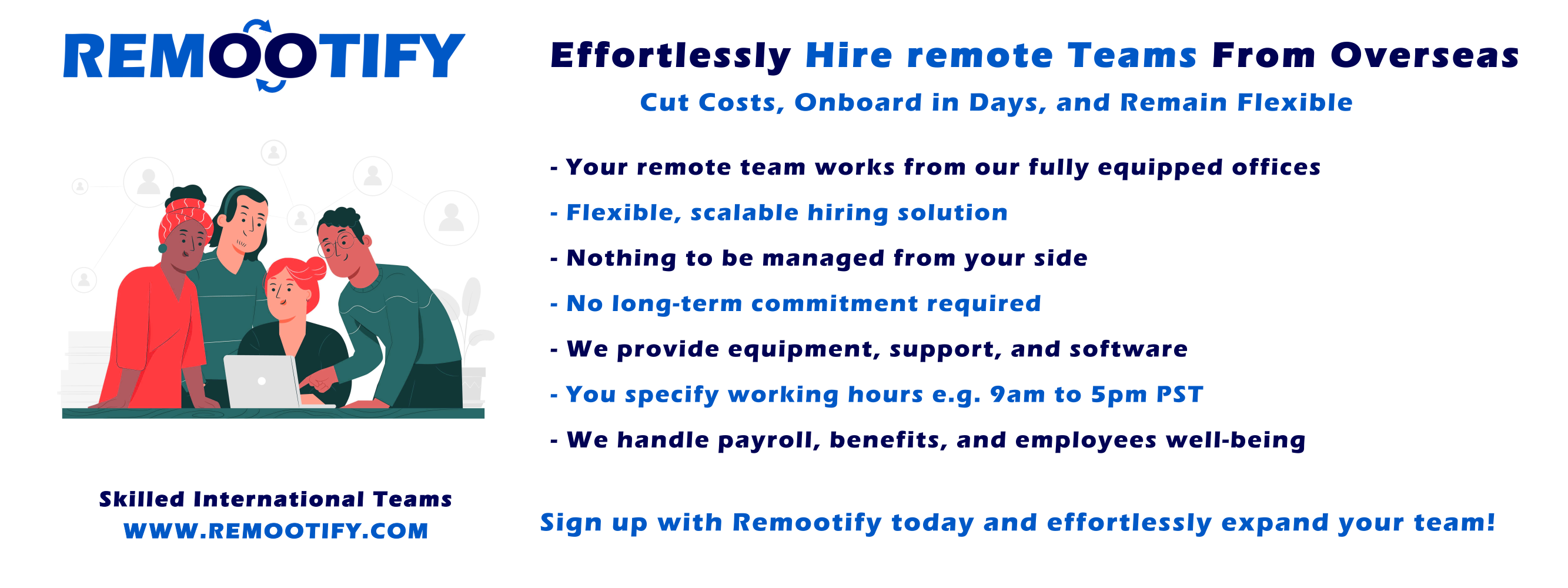Start hiring YOUR REMOTE TEAM, Today!
Enter your information below to start a discussion with one of our team members!

In the dynamic business world, companies’ most critical decisions are handling or outsourcing operations in-house. This choice can significantly impact a company’s efficiency, cost-effectiveness, and overall success.
The decision is not as straightforward as it may seem, as it involves a complex interplay of cost, control, flexibility, and expertise.
This article provides a comprehensive guide to understanding the pros and cons of in-house versus outsourcing and real-world use cases to help you make an informed decision.
Understanding In-House and Outsourcing
Before diving into the pros and cons, it’s essential to understand what in-house and outsourcing entail.
In-House
In-house refers to conducting operations within the company using the company’s resources and employees. This approach allows direct control over the work process, fostering a unified company culture and facilitating immediate communication.
It also ensures that the company’s internal knowledge and expertise are utilized fully. However, it requires a significant investment in time and resources, especially regarding recruitment, training, and retention of employees.
Outsourcing
Outsourcing, on the other hand, involves delegating certain operations or tasks to external agencies or professionals. This can range from hiring freelance professionals to contracting entire departments to specialized companies.
Outsourcing can provide access to a global talent pool and potential cost savings. It allows companies to focus on their core competencies while leaving non-core tasks to experts in the field.
However, it also means relinquishing some control over the work process and potentially facing communication and cultural barriers.
In-House Advantages and Disadvantages
Advantages:-
- Greater control over the work process:- When you handle operations in-house, you have direct control over the work process. You can monitor progress, adjust as needed, and ensure the work aligns with your company’s standards and goals.
- Immediate communication and feedback:- In-house teams can communicate and collaborate more effectively. They can share feedback, resolve issues, and make decisions quickly, improving efficiency and productivity.
- Fosters a unified company culture:- In-house teams are more likely to understand and embody your company’s culture. They share the same values, goals, and vision, which can lead to increased motivation and commitment.
Disadvantages:-
- Can be more costly:- In-house operations can be more costly due to salaries, benefits, and overhead costs. There’s also the cost of recruitment, training, and retention of employees.
- Limited to the skills and expertise of current employees:- If your in-house team lacks certain skills or expertise, it can limit your ability to take on new projects or challenges.
- It may require more time for recruitment and training:- Building an in-house team takes time. You must recruit the right people, train them, and integrate them into your company culture.
Outsourcing Advantages and Disadvantages
Advantages:-
- Access to a global talent pool:- Outsourcing opens up a world of possibilities. You can access a global talent pool and find experts who can deliver high-quality work.
- Potential cost savings:- Outsourcing can be more cost-effective, especially for non-core tasks. You can save on salaries, benefits, overhead, and training expenses.
- Allows the company to focus on core competencies:- By outsourcing non-core tasks, your company can focus on what it does best. This can lead to improved efficiency and productivity.
Disadvantages:-
- Less control over the work process:- When you outsource, you relinquish some control over the work process. This can make it harder to monitor progress and ensure quality.
- Potential communication and cultural barriers:- Working with an external agency or professionals from different cultural backgrounds can lead to communication and cultural barriers. These can affect the efficiency and effectiveness of the work.
- Dependence on an external entity:- Outsourcing creates a dependency on an external entity. If the outsourcing provider fails to deliver, it can disrupt your operations and affect your business.
Comparison Summary Table
| Aspect | Outsourcing | In-House |
|---|---|---|
| Control over the work process | 🔴 | 🟢 |
| Immediate communication | 🔴 | 🟢 |
| Unified company culture | 🔴 | 🟢 |
| Access to global talent | 🟢 | 🔴 |
| Potential cost savings | 🟢 | 🔴 |
| Focus on core competencies. | 🟢 | 🔴 |
| Communication barriers | 🔴 | 🟢 |
| Dependence on outsiders | 🔴 | 🟢 |
| Cost implications | 🔴 | 🟢 |
| Skill limitations | 🟢 | 🔴 |
| Recruitment & training time | 🟢 | 🔴 |
When to Select In-House or Outsourcing?
Choosing between in-house and outsourcing often depends on the specific circumstances and needs of the company.
When to Use In-House:-
- For example, a software company might want to keep software development in-house when the tasks are core to your business.
- When you require close control and coordination, if the tasks involve sensitive data or complex processes, it might be better to keep them in-house.
- The tasks require a deep understanding of the company’s culture and processes. Tasks that involve direct interaction with customers or stakeholders might be better handled in-house.
When to Use Outsourcing:-
- When the tasks are not core to your business, for example, a retail company might choose to outsource its IT services.
- Outsourcing can be a good option when the tasks require specialized skills or expertise if you need expert knowledge not available in-house.
- When you need to scale up quickly for a short-term project, outsourcing can provide the flexibility you need if you have a project that requires additional resources for a limited period.
Companies That Are Using In-House or Outsourcing
To illustrate the concepts, let’s look at some real-world examples of successful in-house operations and outsourcing.
In-House Success in Apple Inc.
Apple Inc. is a prime example of successful in-house operations. The tech giant designs and develops its hardware and software, allowing seamless integration and a unique user experience.
This approach has enabled Apple to maintain high-quality standards and innovate rapidly. It also ensures that Apple’s products have a distinct identity and stand out in the market.
Outsourcing Success in Slack
Slack, the popular communication platform, is a great example of successful outsourcing. In its early stages, Slack outsourced the design of its app to an external agency, allowing the company to focus on developing its core technology.
This decision helped Slack speed up its launch process and deliver a high-quality product. It also allowed Slack to tap into the expertise of the design agency, which had a proven track record in designing successful apps.
Comparison of In-House and Outsourcing in a Single Company
IBM has successfully used in-house and outsourcing. It has a strong in-house team for its core business, while it outsources certain functions like customer service to enhance efficiency and cost-effectiveness. This hybrid approach allows IBM to leverage the best of both worlds.
Frequently Asked Questions
In this section, we answer some of the most frequently asked questions related to in-house vs outsourcing.
1- What is the difference between outsourcing and in-house systems?
In-house systems are managed within the company using the company’s resources and employees. Outsourcing involves delegating certain operations or tasks to external agencies or professionals.
2- What questions to ask when outsourcing?
Some important questions to ask when outsourcing include:
- What is the provider’s track record?
- What skills and expertise do they bring?
- How will they communicate and collaborate with your team?
- What are their costs?
3- Why is in-house development better than outsourcing?
In-house development can be better than outsourcing when the tasks are core to the business, require close supervision, or involve sensitive information. It also allows for greater control over the work process and fosters a unified company culture.
4- What is the difference between outsourced and in-house IT support?
The company’s employees provide in-house IT support, while an external agency or professionals provide outsourced IT support. The choice between the two depends on cost, control, available skills, and the company’s strategic goals.
5- How does outsourcing save money compared to in-house operations?
Outsourcing can save money regarding salaries, benefits, overhead, and training expenses. However, it’s important to consider other factors like communication costs and the cost of managing the outsourcing relationship.
Conclusion
The decision between in-house and outsourcing is not a one-size-fits-all solution. It depends on various factors, including the nature of the task, cost, available skills, and strategic goals.
By understanding the pros and cons of each option and considering your company’s unique needs and circumstances, you can make an informed decision contributing to your company’s success.
Remember, the key is to strike a balance that allows your company to operate efficiently and effectively while fostering innovation and growth.
Whether you choose in-house, outsourcing, or a mix of both, the ultimate goal is to add value to your business and drive its success.





